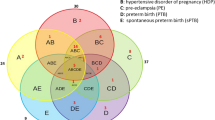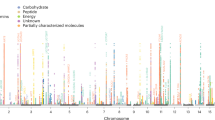Abstract
Pre-eclampsia is a complex multi-system pregnancy disorder with limited treatment options. Therefore, we aimed to screen for metabolites that have causal associations with preeclampsia and to predict target-mediated side effects based on Mendelian randomization (MR) analysis. A two-sample MR analysis was firstly conducted to systematically assess causal associations of blood metabolites with pre-eclampsia, by using metabolites related large-scale genome-wide association studies (GWASs) involving 147,827 European participants, as well as GWASs summary data about pre-eclampsia from the FinnGen consortium R8 release data that included 182,035 Finnish adult female subjects (5922 cases and 176,113 controls). Subsequently, a phenome-wide MR (Phe-MR) analysis was applied to assess the potential on-target side effects associated with hypothetical interventions that reduced the burden of pre-eclampsia by targeting identified metabolites. Four metabolites were identified as potential causal mediators for pre-eclampsia by using the inverse-variance weighted method, including cholesterol in large HDL (L-HDL-C) [odds ratio (OR): 0.88; 95% confidence interval (95% CI): 0.83–0.93; P = 2.14 × 10−5), cholesteryl esters in large HDL (L-HDL-CE) (OR: 0.88; 95% CI: 0.83–0.94; P = 5.93 × 10−5), free cholesterol in very large HDL (XL-HDL-FC) (OR: 0.88; 95% CI: 0.82–0.94; P = 1.10 × 10−4) and free cholesterol in large HDL (L-HDL-FC) (OR: 0.89; 95% CI: 0.84–0.95; P = 1.45 × 10−4). Phe-MR analysis showed that targeting L-HDL-CE had beneficial effects on the risk of 24 diseases from seven disease chapters. Based on this systematic MR analysis, L-HDL-C, L-HDL-CE, XL-HDL-FC, and L-HDL-FC were inversely associated with the risk of pre-eclampsia. Interestingly, L-HDL-CE may be a promising drug target for preventing pre-eclampsia with no predicted detrimental side effects.

The study consists of a two-stage design that conducts MR at both stages. First, we assessed the causality for the associations between 194 blood metabolites and the risk of pre-eclampsia. Second, we investigated a broad spectrum of side effects associated with the targeting identified metabolites in 693 non-preeclampsia diseases. Our results suggested that Cholesteryl esters in large HDL may serve as a promising drug target for the prevention or treatment of pre-eclampsia with no predicted detrimental side effects.
This is a preview of subscription content, access via your institution
Access options
Subscribe to this journal
Receive 12 print issues and online access
$259.00 per year
only $21.58 per issue
Buy this article
- Purchase on Springer Link
- Instant access to full article PDF
Prices may be subject to local taxes which are calculated during checkout



Similar content being viewed by others
References
Chappell LC, Cluver CA, Kingdom J, Tong S. Pre-eclampsia. Lancet. 2021;398:341–54.
Dimitriadis E, Rolnik DL, Zhou W, Estrada-Gutierrez G, Koga K, Francisco RPV, et al. Pre-eclampsia. Nat Rev Dis Prim. 2023;9:22.
Espinoza J, Vidaeff A, Pettker CM, Simhan H, Amer Coll Obstet G. Gestational hypertension and preeclampsia. Obstet Gynecol. 2020;135:E237–60.
Magee LA, Nicolaides KH, von Dadelszen P. Preeclampsia. N Engl J Med. 2022;386:1817–32.
Atallah A, Lecarpentier E, Goffinet F, Doret-Dion M, Gaucherand P, Tsatsaris V. Aspirin for prevention of preeclampsia. Drugs. 2017;77:1819–31.
Davidson KW, Barry MJ, Mangione CM, Cabana M, Caughey AB, Davis EM, et al. Aspirin use to prevent preeclampsia and related morbidity and mortality US preventive services task force recommendation statement. J Am Med Assoc. 2021;326:1186–91.
Henderson JT, Vesco KK, Senger CA, Thomas RG, Redmond N. Aspirin use to prevent preeclampsia and related morbidity and mortality: updated evidence report and systematic review for the US preventive services task force. JAMA. 2021;326:1192–206.
Johnson CH, Ivanisevic J, Siuzdak G. Metabolomics: beyond biomarkers and towards mechanisms. Nat Rev Mol Cell Biol. 2016;17:451–9.
Onuh JO, Qiu HY. Metabolic profiling and metabolites fingerprints in human hypertension: discovery and potential. Metabolites. 2021;11:17.
Arnett DK, Claas SA. Omics of blood pressure and hypertension. CircRes. 2018;122:1409–19.
McGarrah RW, Crown SB, Zhang GF, Shah SH, Newgard CB. Cardiovascular metabolomics. CircRes. 2018;122:1238–58.
Ussher JR, Elmariah S, Gerszten RE, Dyck JRB. The emerging role of metabolomics in the diagnosis and prognosis of cardiovascular disease. J Am Coll Cardiol. 2016;68:2850–70.
Emdin CA, Khera AV, Kathiresan S. Mendelian randomization. J Am Med Assoc. 2017;318:1925–6.
Bennett DA, Holmes MV. Mendelian randomisation in cardiovascular research: an introduction for clinicians. Heart. 2017;103:1400–7.
King EA, Davis JW, Degner JF. Are drug targets with genetic support twice as likely to be approved? Revised estimates of the impact of genetic support for drug mechanisms on the probability of drug approval. PLoS Genet. 2019;15:e1008489.
Nelson MR, Tipney H, Painter JL, Shen JD, Nicoletti P, Shen YF, et al. The support of human genetic evidence for approved drug indications. Nat Genet. 2015;47:856.
Hasin Y, Seldin M, Lusis A. Multi-omics approaches to disease. Genome Biol. 2017;18:15.
Kettunen J, Demirkan A, Wurtz P, Draisma HHM, Haller T, Rawal R, et al. Genome-wide study for circulating metabolites identifies 62 loci and reveals novel systemic effects of LPA. Nat Commun. 2016;7:9.
Salomaa V. Nightingale Health and UK Biobank announces major initiative to analyse half a million blood samples to facilitate global medical research. https://www.ukbiobank.ac.uk/learn-more-about-uk-biobank/news/nightingale-health-and-uk-biobank-announces-major-initiative-to-analyse-half-a-million-blood-samples-to-facilitate-global-medical-research. Accessed April 4.
Shin SY, Fauman EB, Petersen AK, Krumsiek J, Santos R, Huang J, et al. An atlas of genetic influences on human blood metabolites. Nat Genet. 2014;46:543–50.
Ardissino M, Slob EAW, Rajasundaram S, Reddy RK, Woolf B, Girling J, et al. Safety of beta-blocker and calcium channel blocker antihypertensive drugs in pregnancy: a Mendelian randomization study. BMC Med. 2022;20:10.
Li PS, Wang HY, Guo L, Gou XY, Chen GD, Lin DX, et al. Association between gut microbiota and preeclampsia-eclampsia: a two-sample Mendelian randomization study. BMC Med. 2022;20:10.
Kurki MI, Karjalainen J, Palta P, Sipilä TP, Kristiansson K, Donner K, et al. FinnGen: unique genetic insights from combining isolated population and national health register data. Genet Genom Med. 2022. https://doi.org/10.1101/2022.03.03.22271360.
Zhou W, Nielsen JB, Fritsche LG, Dey R, Gabrielsen ME, Wolford BN, et al. Efficiently controlling for case-control imbalance and sample relatedness in large-scale genetic association studies. Nat Genet. 2018;50:1335.
Chong M, Sjaarda J, Pigeyre M, Mohammadi-Shemirani P, Lali R, Shoamanesh A, et al. Novel drug targets for ischemic stroke identified through Mendelian randomization analysis of the blood proteome. Circulation. 2019;140:819–30.
Hemani G, Zhengn J, Elsworth B, Wade KH, Haberland V, Baird D, et al. The MR-Base platform supports systematic causal inference across the human phenome. eLife. 2018;7:29.
Cai JH, Chen X, Wang HX, Wei ZX, Li M, Rong XM, et al. Iron status may not affect amyotrophic lateral sclerosis: a Mendelian randomization study. Front Genet. 2021;12:8.
Burgess S, Thompson SG, Collaboration CCG. Avoiding bias from weak instruments in Mendelian randomization studies. Int J Epidemiol. 2011;40:755–64.
Burgess S, Butterworth A, Thompson SG. Mendelian randomization analysis with multiple genetic variants using summarized data. Genet Epidemiol. 2013;37:658–65.
Higgins JPT, Thompson SG, Deeks JJ, Altman DG. Measuring inconsistency in meta-analyses. Br Med J. 2003;327:557–60.
Zhao QY, Wang JS, Hemani G, Bowden J, Small DS. Statistical inference in two-sample summary-data Mendelian randomization using robust adjusted profile score. Ann Stat. 2020;48:1742–69.
Burgess S, Thompson SG. Interpreting findings from Mendelian randomization using the MR-Egger method. Eur J Epidemiol. 2017;32:377–89.
Barter PJ, Rye KA. HDL cholesterol concentration or HDL function: which matters? Eur Heart J. 2017;38:2487–9.
Otvos JD. Measurement of lipoprotein subclass profiles by nuclear magnetic resonance spectroscopy. Clin Lab. 2002;48:171–80.
Michos ED, McEvoy JW, Blumenthal RS. Lipid management for the prevention of atherosclerotic cardiovascular disease. N Engl J Med. 2019;381:1557–67.
Lincoff AM, Nicholls SJ, Riesmeyer JS, Barter PJ, Brewer HB, Fox KAA, et al. Evacetrapib and cardiovascular outcomes in high-risk vascular disease. N Engl J Med. 2017;376:1933–42.
Pappa E, Elisaf MS, Kostara C, Bairaktari E, Tsimihodimos VK. Cardioprotective properties of HDL: structural and functional considerations. Curr Med Chem. 2020;27:2964–78.
Leon LJ, McCarthy FP, Direk K, Gonzalez-Izquierdo A, Prieto-Merino D, Casas JP, et al. Preeclampsia and cardiovascular disease in a large UK pregnancy cohort of linked electronic health records A CALIBER Study. Circulation. 2019;140:1050–60.
Shahid R, Bari MF, Hussain M. Serum biomarkers for the prediction and diagnosis of preeclampsia: a meta-analysis. J Taibah Univ Med Sci. 2022;17:14–27.
Hosier H, Lipkind HS, Rasheed H, DeWan AT, Rogne T. Dyslipidemia and risk of preeclampsia: a multi ancestry mendelian randomization study. Hypertension. 2023;80:1067–76.
Holmes MV, Millwood IY, Kartsonaki C, Hill MR, Bennett DA, Boxall R, et al. Lipids, lipoproteins, and metabolites and risk of myocardial infarction and stroke. J Am Coll Cardiol. 2018;71:620–32.
Li JJ, Zhang Y, Li S, Cui CJ, Zhu CG, Guo YL, et al. Large HDL subfraction but not HDL-C is closely linked with risk factors, coronary severity and outcomes in a cohort of nontreated patients with stable coronary artery disease: a prospective observational study. Med (Baltim). 2016;95:e2600.
Zhang Y, Gordon SM, Xi H, Choi S, Paz MA, Sun R, et al. HDL subclass proteomic analysis and functional implication of protein dynamic change during HDL maturation. Redox Biol. 2019;24:101222.
Tosi MR, Tugnoli V. Cholesteryl esters in malignancy. Clin Chim Acta. 2005;359:27–45.
Shrestha S, Wu BJ, Guiney L, Barter PJ, Rye KA. Cholesteryl ester transfer protein and its inhibitors. J Lipid Res. 2018;59:772–83.
Girona J, Amigo N, Ibarretxe D, Plana N, Rodriguez-Borjabad C, Heras M, et al. HDL triglycerides: a new marker of metabolic and cardiovascular risk. Int J Mol Sci. 2019;20:10.
Blauw LL, Noordam R, Soidinsalo S, Blauw CA, Li-Gao RF, de Mutsert R, et al. Mendelian randomization reveals unexpected effects of CETP on the lipoprotein profile. Eur J Hum Genet. 2019;27:422–31.
Martinez LO, Najib S, Perret B, Cabou C, Lichtenstein L. Ecto-F1-ATPase/P2Y pathways in metabolic and vascular functions of high density lipoproteins. Atherosclerosis. 2015;238:89–100.
Abe RJ, Abe JI, Nguyen MTH, Olmsted-Davis EA, Mamun A, Banerjee P, et al. Free cholesterol bioavailability and atherosclerosis. Curr Atheroscler Rep. 2022;24:323–36.
Gillard BK, Rosales C, Xu B, Gotto AM, Jr., Pownall HJ, Rethinking reverse cholesterol transport and dysfunctional high-density lipoproteins. J Clin Lipido. 2018;12:849–56.
Acknowledgements
We thank the authors and participants of all GWASs that we have used, for making their results publicly available. Full acknowledgment and funding statements for each of these resources are available via the relevant cited reports.
Funding
This study was supported by the National Natural Science Fund of China (grant number: 82273635).
Author information
Authors and Affiliations
Corresponding author
Ethics declarations
Conflict of interest
The authors declare no competing interests.
Additional information
Publisher’s note Springer Nature remains neutral with regard to jurisdictional claims in published maps and institutional affiliations.
Supplementary information
Rights and permissions
Springer Nature or its licensor (e.g. a society or other partner) holds exclusive rights to this article under a publishing agreement with the author(s) or other rightsholder(s); author self-archiving of the accepted manuscript version of this article is solely governed by the terms of such publishing agreement and applicable law.
About this article
Cite this article
Ding, Y., Yao, M., Liu, J. et al. Association between human blood metabolome and the risk of pre-eclampsia. Hypertens Res 47, 1063–1072 (2024). https://doi.org/10.1038/s41440-024-01586-x
Received:
Revised:
Accepted:
Published:
Issue Date:
DOI: https://doi.org/10.1038/s41440-024-01586-x
Keywords
This article is cited by
-
A fascinating association between HDL as a multi-potent particle and hypertension
Hypertension Research (2024)



